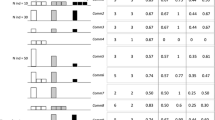Abstract
A desirable property of a diversity index is strict concavity. This implies that the pooled diversity of a given community sample is greater than or equal to but not less than the weighted mean of the diversity values of the constituting plots. For a strict concave diversity index, such as species richness S, Shannon's entropy H or Simpson's index 1-D, the pooled diversity of a given community sample can be partitioned into two non-negative, additive components: average within-plot diversity and between-plot diversity. As a result, species diversity can be summarized at various scales measuring all diversity components in the same units. Conversely, violation of strict concavity would imply the non-interpretable result of a negative diversity among community plots. In this paper, I apply this additive partition model generally adopted for traditional diversity measures to Aczél and Daróczy's generalized entropy of type α. In this way, a parametric measure of β-diversity is derived as the ratio between the pooled sample diversity and the average within-plot diversity that represents the parametric analogue of Whittaker's β-diversity for data on species relative abundances.
Similar content being viewed by others
REFERENCES
Aczél, J. and Z. Daróczy (1975). On Measures of Information and their Characterizations. Academic Press, New York.
Allan, J.D. (1975). Components of diversity. Oecologia 18: 359–367.
Barazzuoli, P., G. Guasparri and M. Salleolini (1993). II clima. In: Giusti, F. (Ed.), La Storia Naturale della Toscana Meridionale, pp. 141–171. Pizzi Editore, Milano.
Beck, C. and F. Schlögl (1993). Thermodynamics of chaotic systems. Cambridge University Press, Cambridge.
Berger, W.H. and F.L. Parker (1970). Diversity of planctonic Foraminifera in deep sea sediments. Science 168: 1345–1347.
Chiarucci, A., B. Foggi and F. Selvi (1995). Garigue plant communities of ultramafic outcrops of Tuscany. Webbia 49: 179–195.
Chiarucci, A., S. Maccherini, I. Bonini and V. De Dominicis (1998). Effects of nutrient addition on species diversity and ground cover of “serpentine” vegetation. Plant Biosystems 132: 143–150.
Efron, B. (1982). The Jackknife, the Bootstrap, and other Resampling Plans. SIAM, Philadelphia.
Feoli, E., M. Lagonegro and L. Orlóci (1984). Information Analysis of Vegetation Data. Dr. W. Junk Publisher, The Hague.
He, X.S. and L. Orlóci (1993). Comparative diversity analysis of vegetation. Abstracta Botanica 17: 79–86.
Hill, M.O. (1973). Diversity and evenness: a unifying notation and its consequences. Ecology 54: 427–431.
Lande, R. (1996). Statistics and partitioning of species diversity, and similarity among multiple communities. Oikos 76: 5–13.
Lewontin, R.C. (1972). The apportionment of human diversity. Evolutionary Biology 6: 381–398.
MacArthur, R.H. (1955). Fluctuation of animal populations and a measure of community stability. Ecology 36: 533–536.
MacArthur, R.H. (1965). Patterns of species diversity. Biological Reviews 40: 510–533.
Margalef, D.R. (1958). Information theory in ecology. General Systems Yearbook 3: 36–71.
Magurran, A. (1988). Ecological Diversity and its Measurement. Princeton University Press, Princeton, NJ.
Nei, M. (1973). Analysis of gene diversity in subdivided populations. Proceedings of the National Academy of Sciences of the United States of America 70: 3321–3323.
Orlóci, L. (1978). Multivariate Analysis in Vegetation Research, 2nd ed. Dr. W. Junk Publisher, The Hague.
Orlóci, L. (1991). Entropy and Information. SPB Academic Publishing, The Hague.
Orlóci, L., M. Anand and V.D. Pillar (2002). Biodiversity analysis: issues, concepts, techniques. Community Ecology 3: 217–236.
Patil, G.P. and C. Taillie (1982). Diversity as a concept and its measurement. Journal of the American Statistical Association 77: 548–567.
Pielou, E.C. (1966). Shannon's formula as a measure of species diversity: its use and misuse. American Naturalist 100: 463–465.
Pielou, E.C. (1975). Ecological Diversity. Wiley, New York.
Podani, J. (1992). Space series analysis: processes reconsidered. Abstracta Botanica 16: 25–29.
Podani, J., T. Czárán and S. Bartha (1993). Pattern, area and diversity: the importance of spatial scale in species assemblages. Abstracta Botanica 17: 37–51.
Rényi, A. (1970). Probability Theory. North Holland Publishing Company, Amsterdam.
Ricotta, C. (2000). From theoretical ecology to statistical physics and back: self-similar landscape metrics as a synthesis of ecological diversity and geometrical complexity. Ecological Modelling 125: 245–253.
Ricotta, C. and G.C. Avena (2002). On the information-theoretical meaning of Hill's parametric evenness. Acta Biotheoretica 50: 63–71.
Ricotta, C., M.L. Carranza and G.C. Avena (2002). Computing β-diversity from species-area curves. Basic and Applied Ecology 3: 15–18.
Shannon, C. (1948). A mathematical theory of communication. Bell Systems Technical Journal 27: 379–423.
Simpson, E.H. (1949). Measurement of diversity. Nature 163: 688.
Tóthmérész, B. (1995). Comparison of different methods for diversity ordering. Journal of Vegetation Science 6: 283–290.
Tsallis, C. (2002). Entropic nonextensivity: a possible measure of complexity. Chaos, Solitons and Fractals 13: 371–391.
Wagner, H.H., O. Wildi and K. Ewald (2000). Additive partitioning of plant species diversity in an agricultural mosaic landscape. Landscape Ecology 15: 219–227.
Whittaker, R.H. (1960). Vegetation of the Siskiyou Mountains, Oregon and California. Ecological Monographs 30: 279–338.
Whittaker, R.H. (1972). Evolution and measurement of species diversity. Taxon 21: 213–251.
Author information
Authors and Affiliations
Rights and permissions
About this article
Cite this article
Ricotta, C. Additive Partition of Parametric Information and Its Associated β-Diversity Measure. Acta Biotheor 51, 91–100 (2003). https://doi.org/10.1023/A:1024539526618
Issue Date:
DOI: https://doi.org/10.1023/A:1024539526618




